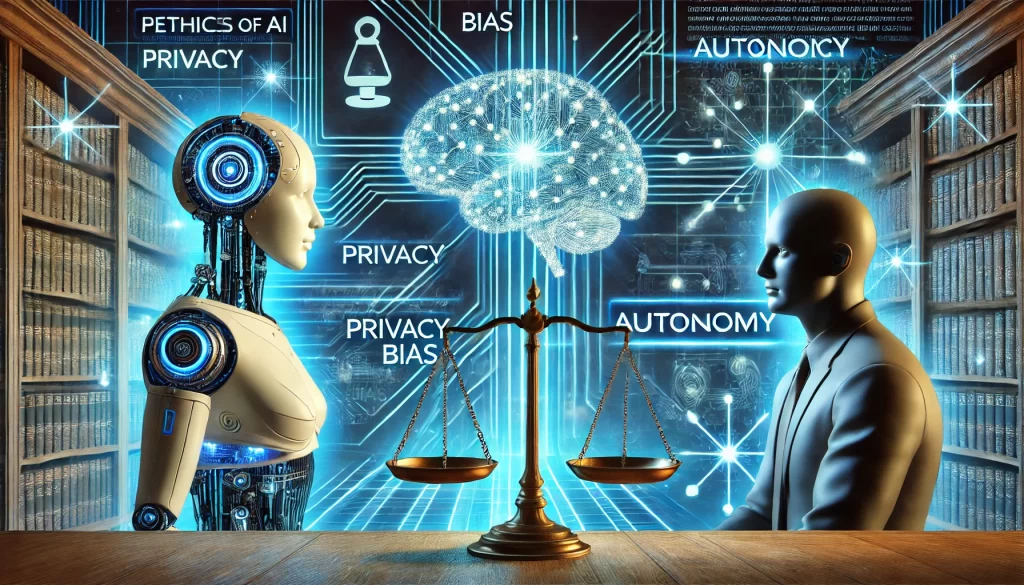Artificial Intelligence (AI) is no longer a futuristic concept—it’s here, reshaping industries, influencing decisions, and altering how we interact with the world. From personalized recommendations on streaming platforms to life-saving medical diagnostics, AI’s applications are vast and growing. But as this technology becomes more embedded in daily life, critical questions about its ethical implications demand answers. How do we ensure AI systems are fair? Who is responsible when an AI makes a harmful decision? Can we trust machines to respect our privacy?
In this deep dive, we’ll explore the ethical landscape of AI, unpacking its challenges, controversies, and potential solutions. Whether you’re a tech enthusiast, a concerned citizen, or a business leader, understanding these issues is crucial to navigating the AI-driven future responsibly.
What Is AI Ethics?
AI ethics refers to the moral principles and practices that guide the development, deployment, and use of artificial intelligence. It’s about ensuring AI technologies align with human values, prioritize societal well-being, and avoid harm. Unlike traditional software, AI systems often operate as “black boxes,” making decisions that even their creators struggle to explain. This complexity raises unique ethical dilemmas, including:
- Bias and discrimination in algorithms
- Transparency (or lack thereof) in decision-making
- Privacy risks from data collection
- Accountability for AI-driven actions
- Job displacement due to automation
These challenges aren’t just theoretical. Real-world examples—from racially biased facial recognition to AI hiring tools that filter out qualified candidates—highlight the urgent need for ethical frameworks.
The Rise of AI: Opportunities and Pitfalls
Before diving into ethics, it’s worth acknowledging AI’s transformative potential. In healthcare, AI accelerates drug discovery and improves diagnostic accuracy. In climate science, it models environmental changes to inform policy. Businesses leverage AI to streamline operations, while educators use it to personalize learning.
Yet, unchecked AI development risks unintended consequences. Consider the following scenarios:
- A bank uses an AI loan-approval system trained on historical data. Unknowingly, the AI denies loans to marginalized communities, perpetuating systemic inequality.
- A self-driving car swerves to avoid a pedestrian but injures its passenger. Who is liable—the manufacturer, the software developer, or the vehicle owner?
- An employer relies on an AI tool to screen resumes, but the algorithm favors candidates from specific demographics, stifling workplace diversity.
These examples underscore why ethics can’t be an afterthought. As AI grows more autonomous, the stakes—for individuals and society—rise exponentially.
Key Ethical Challenges in AI
1. Bias and Fairness: Is AI Inherently Discriminatory?
AI systems learn from data, and if that data reflects historical biases, the AI will too. For instance:
- A 2018 study found that commercial facial recognition systems had error rates of 34% for dark-skinned women vs. 0.8% for light-skinned men.
- In 2020, Twitter’s image-cropping algorithm consistently prioritized white faces over Black faces.
Why does this happen? Bias creeps in at multiple stages:
- Data collection: Training data underrepresents minority groups.
- Algorithm design: Developers may unknowingly encode prejudices.
- Deployment: Systems are tested in limited contexts, missing edge cases.
Solutions:
- Audit datasets for representativeness.
- Use “fairness-aware” algorithms that correct for bias.
- Involve diverse teams in AI development.
2. Transparency: The “Black Box” Problem
Many AI models, especially deep learning systems, are opaque. Even experts struggle to explain how they reach specific conclusions. This lack of transparency becomes dangerous in high-stakes fields like healthcare or criminal justice.
Case in point: In 2016, ProPublica revealed that COMPAS, a risk-assessment tool used in U.S. courts, was twice as likely to falsely label Black defendants as high-risk compared to white defendants. Judges relied on its predictions without understanding how they were generated.
The push for explainability:
- Explainable AI (XAI): Techniques like LIME or SHAP help decode complex models.
- Regulations: The EU’s proposed AI Act mandates transparency for high-risk systems.
3. Privacy: Balancing Innovation and Data Rights
AI thrives on data—often personal data. While this enables breakthroughs, it also risks mass surveillance, identity theft, and erosion of trust.
- Facial recognition: Used for security but also to track protesters or suppress dissent.
- Data brokers: Sell personal information to train AI, often without consent.
Protecting privacy:
- Data minimization: Collect only what’s necessary.
- Anonymization: Strip datasets of identifiable information.
- Stronger laws: GDPR (EU) and CCPA (California) set benchmarks for data rights.
4. Accountability: Who’s Responsible When AI Fails?
When an AI system causes harm—a misdiagnosis, a faulty stock trade, a fatal car crash—assigning blame is murky. Traditional liability laws aren’t equipped to handle autonomous systems.
The accountability gap:
- Manufacturers blame flawed data.
- Developers blame misunderstood user instructions.
- Users blame opaque algorithms.
Filling the gap:
- Clear governance frameworks: Define roles for developers, deployers, and users.
- AI insurance: Emerging policies to cover AI-related risks.
5. Job Displacement: Will AI Create or Destroy Opportunities?
AI automates routine tasks, boosting efficiency but threatening jobs. The World Economic Forum estimates 85 million jobs may disappear by 2025, while 97 million new roles could emerge.
The catch: New jobs often require advanced skills, leaving low-income workers vulnerable.
Ethical responses:
- Reskilling programs: Governments and companies must invest in education.
- Universal Basic Income (UBI): Proposed as a buffer against automation-induced unemployment.
6. Autonomous Systems: Machines Making Life-or-Death Choices
Self-driving cars, military drones, and medical robots force us to confront moral dilemmas. For example, how should an autonomous vehicle prioritize lives in an unavoidable crash?
The “trolley problem” revisited:
- Utilitarian AI might minimize total casualties, but is that ethically acceptable?
- Should machines make such decisions at all?
The need for ethical programming:
- Public input on AI decision rules.
- International bans on lethal autonomous weapons.
Global and Cultural Dimensions of AI Ethics
Ethical norms vary globally. Western notions of privacy differ from collectivist cultures. China’s social credit system, which uses AI to monitor citizen behavior, clashes with European privacy values.
Key conflicts:
- Free speech vs. censorship: AI content moderation balances hate speech prevention with stifling dissent.
- Surveillance vs. security: Post-9/11, the U.S. expanded surveillance, while the EU prioritizes data protection.
Building inclusive AI:
- Engage multicultural stakeholders in policy-making.
- Avoid “ethical imperialism”—imposing one region’s values globally.
Regulatory Responses: Are Laws Keeping Up?
Governments are scrambling to regulate AI without stifling innovation. Notable efforts include:
- EU AI Act (2023): Bans high-risk applications like social scoring and requires transparency for AI in education, hiring, and law enforcement.
- U.S. Algorithmic Accountability Act (2022): Mandates bias assessments for automated systems.
- China’s AI Ethics Guidelines: Emphasize human control and social stability.
Challenges:
- Regulations lag behind technological advances.
- Enforcement is fragmented across borders.
The Path Forward: Building Ethical AI
Creating ethical AI isn’t just a technical challenge—it’s a societal one. Here’s how we can act:
- For developers:
- Adopt ethical guidelines like IEEE’s Ethically Aligned Design.
- Prioritize fairness, transparency, and privacy in system design.
- For businesses:
- Conduct AI ethics audits.
- Establish ethics review boards.
- For policymakers:
- Fund independent AI safety research.
- Promote international cooperation on standards.
- For individuals:
- Demand transparency from AI services.
- Support organizations advocating for ethical tech.
Conclusion: Ethics Can’t Be an Afterthought
AI holds immense promise, but its ethical risks are equally profound. Without proactive measures, we risk entrenching inequality, eroding privacy, and ceding life-altering decisions to unaccountable machines. The solution isn’t to halt AI progress but to steer it with foresight, empathy, and collective responsibility.
As users, creators, and citizens, we all have a role in shaping AI’s future. By asking tough questions, holding powerful actors accountable, and advocating for inclusive policies, we can ensure AI serves humanity—not the other way around.


